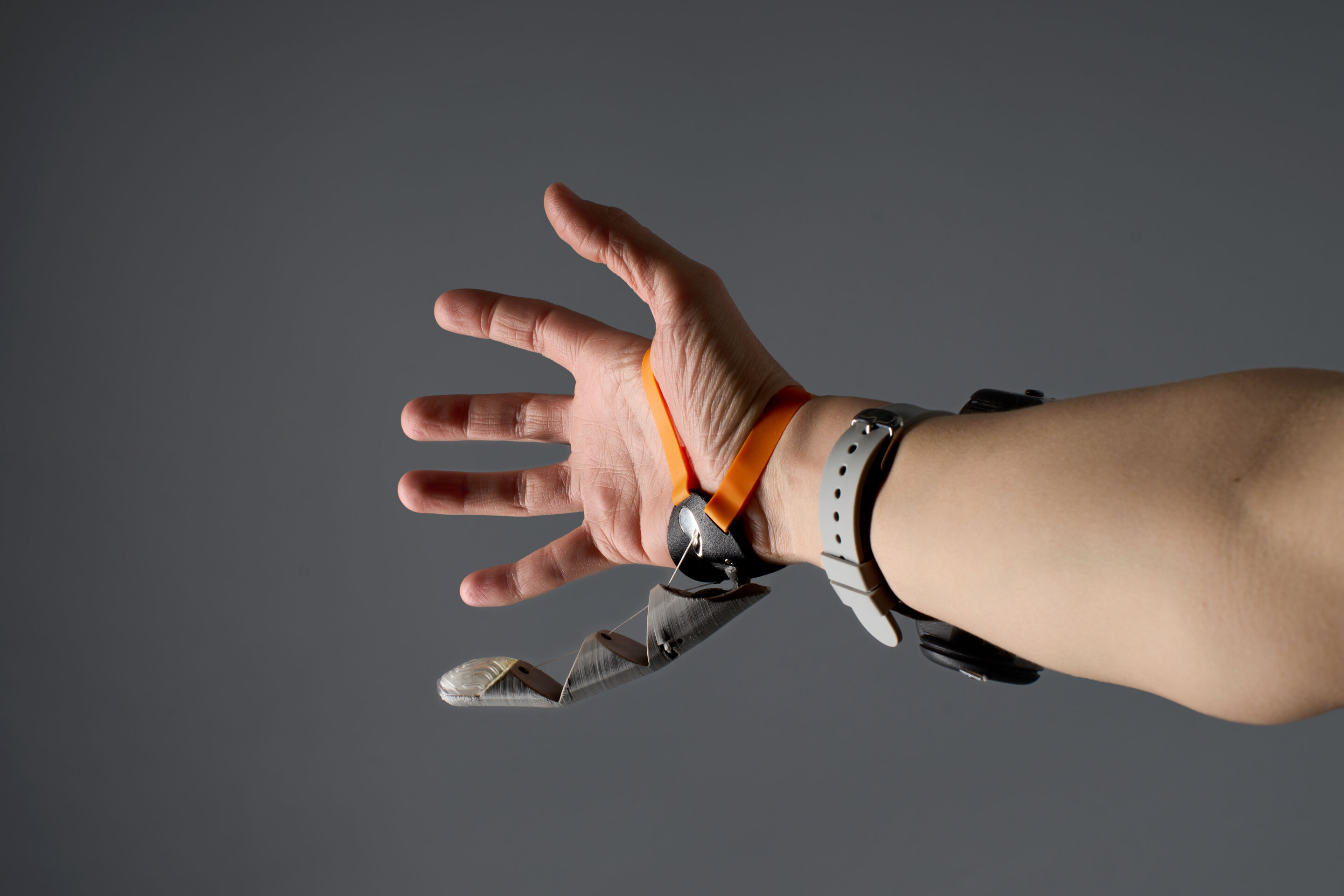Cambridge researchers have shown that members of the public have little trouble in learning very quickly how to use a third thumb—a controllable, prosthetic extra thumb—to pick up and manipulate objects.
The team tested the robotic device on a diverse range of participants, which they say is essential for ensuring new technologies are inclusive and can work for everyone. The results are published in Science Robotics.
An emerging area of future technology is motor augmentation—using motorized wearable devices such as exoskeletons or extra robotic body parts to advance our motor capabilities beyond current biological limitations.
While such devices could improve the quality of life for healthy individuals who want to enhance their productivity, the same technologies can also provide people with disabilities new ways to interact with their environment.
…
Dani Clode, a collaborator within Professor Makin’s lab, has developed the Third Thumb, an extra robotic thumb aimed at increasing the wearer’s range of movement, enhancing their grasping capability and expanding the carrying capacity of the hand. This allows the user to perform tasks that might be otherwise challenging or impossible to complete with one hand or to perform complex multi-handed tasks without having to coordinate with other people.
The Third Thumb is worn on the opposite side of the palm to the biological thumb and controlled by a pressure sensor placed under each big toe or foot. Pressure from the right toe pulls the Thumb across the hand, while the pressure exerted with the left toe pulls the Thumb up toward the fingers. The extent of the Thumb’s movement is proportional to the pressure applied, and releasing pressure moves it back to its original position.
Christian Grey approves

He talks a lot about inclusivity, but the design isn’t open source, very corpo DEI.
Subscribe now to thumb Prime, unlimited thumbings for just $9.99 a month!
I’m sorry, but what does Corpo DEI mean?
Corpo = corporate, DEI = diversity equality/equity inclusion. The kind of cya (cover your ass) policy corporations have, that is neither diverse nor equal nor inclusive.
Okay, yeah, I had the right thing. I guess I’m not sure how it follows.
Mostly just the whole thing of talking a lot about inclusivity without doing anything to actually help.
If people are having no trouble with that they need to start testing tentacles.
Oh tentacles … I thought you said something else … I’ll get my hand out of my pants now
I read it right and still have my hands in my pants.
All well and good, but which one of you has their hands in my pants?
… those aren’t hands
Oh dear.
They might be thumbs though.
Not sure that helps.
Fingers are just tentacles with bones
deleted by creator
I love the wordplay!
‘Titleporn’
I’ll take three.
to be able to do more work? No, thank you
Think of it more as a wanking upgrade.
Extra thumb that gives me an advantage in a video game? Yes please
It’s an interesting piece of research, but I don’t expect anytlike this to become mainstream.
One thought I had was that music could become more accessible in some ways, while also potential for new composition.
Where is the second thumb?
👍
Wouldn’t giving a thumbs signal with two thumbs on one hand give you both a thumbs up and a thumbs down simultaneously?
Or a triple thumbs up 👍👍👍
You can even fancy up your 🤘 beyond 🤟
You could also take The Shocker to the next level.
we gotta add a third prosthetic hole
In the imminent posthuman future extra orifices will definitely be on the men.
Sync it up to the pelvic muscles.
Well that’s a strange place to put a dildo. Sigh, unzips…
I’ve had the hypothesis that our brains are more general purpose than specific to our bodies for a while, based on things like how quickly and fully we can adapt to using tools and vehicles. As well as people who have a mutation for an extra finger being able to use that finger. We learn how contracting and relaxing various muscles causes our bodies to move and use the same mechanisms to figure out how to control vehicles or aim tools.
Sure I’ve seen this before, would be cooler if it was controlled by nerves rather than a pressure sensor.
It’d be way cooler if it was physical tethers instead of fucking bluetooth.
The added dexterity is very enticing to me as someone who primarily does finnacky shit with their hands. But just the potential of a “forgot to charge my thumb” situation is a deal breaker.
kids these days only wanna eat hot chip lie and charge they thumb
Just learn to use your pinky finger sideways and it’s like a second thumb on that hand. I’ve been doing that for years and it feels right to me now. Most people tend to neglect the use of the smallest finger, preferring the familiar strength of the other larger digits, but the pinky can be trained to be more useful.
sounds kind of fun, would help typing, gaming, using tools…
I don’t think prosthesis like this are at a level where they can meaningfully contribute to typing
Ok then play a videogame with it.
This thumb and the experiment I saw that gave people an internal compass similar to a bird with just an EEG cap have me wanting so many body mods that could technically exist…
Fellow furries: Imagine having a wearable tail that moves based on signals from your brain so it actually wags when you’re happy or excited. Imagine also being able to feel it as if it was part of your body. That shit is actually possible right now. It’s not perfect (feeling things is more of a “phantom limb” sensation because there are no actual nerves), but I’m still stoked.













